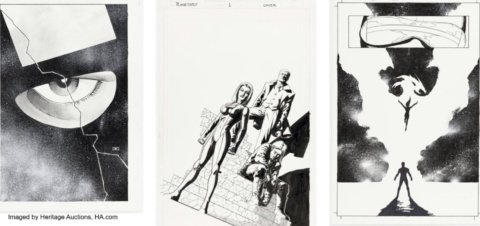What if you had a biennial… of museum artefacts? This is the question posed by the Islamic Arts Biennale—a lavishly staged but fundamentally idiosyncratic proposition that returns to Jeddah in January next year.
The Saudi biennial was a surprising success in its first edition in 2023, where it did away with many conventions. It set religious and spiritual work amid the largely secular field of contemporary art, it brought together works of vastly different time periods, and hosted a gallery of Islamic art collections.
This last facet might seem like a dry observation—inside baseball for biennial folk—but reveals the shifts that the Saudi exhibition is making in response to its wider purview, as well as long-term strategic thinking for its foundation. The biennial is overseen by the ministry of culture’s Diriyah Biennale Foundation, which also organises the Diriyah Contemporary Art Biennale, each on alternating years.
“We had the idea in 2023 but we are really growing it exponentially for 2025: what I would call the institutional participation, inviting libraries and museums of Islamic art to Al Madar to participate,” Abdul Rahman Azzam says. The historian is curating the section called “Al Madar”, in which more than 30 different institutions have been tasked with contributing elements of their collections around the theme of numbers, which are fundamental to mathematics, geometry, and the Islamic religion. The biennial, titled And all that is in between, is this year curated by Julian Raby, Azzam, Amin Jaffer, and the artist Muhannad Shono, who will put together the sizeable contemporary section and its commissions.
Jaffer, a curator and former Christie’s specialist, oversees a further gallery dedicated to two private collections, that of Sheikh Hamad bin Abdullah Al Thani, a cousin of the current emir of Qatar, and of Rifaat Sheikh El Ard, a Saudi national who likewise has extensive holdings of Islamic art.
The inclusion reflects the different landscape of Islamic art. Azzam explains that they sought to give voice not just to each particular collections’ works, but also how they conceive of and contextualise them.
“Indonesia is the largest Muslim country, and yet, when it comes to Islamic art and culture, it is totally underrepresented in the museums of the West,” he says. “Instead, a lot of the things that they feel are fundamental to Islamic art and culture are labelled as ethnographic or anthropological.”
Though often seen as connected to Hindu mythology, Indonesia’s extraordinary carved leather shadow puppets also form part of its Islamic tradition, he notes. In inviting three organisations from the country, the biennial is seeking to open its doors to other interpretations of Islamic art beyond the standard Mamluk and Ottoman artefacts.
Other loaners include the Musée du Louvre, the Bodleian Library in Oxford, the Qatar National Library, and the Vatican (the latter of which does not have diplomatic relations with Saudi). Smaller collections are also contributing work, such as the Ahmed Baba Institute of Higher Learning and Islamic Research in Timbuktu and institutional lenders from Uzbekistan.
These relationships will lay the groundwork for potential further partnerships, whether on a museum or scholarship level. This includes logistical coordination—creating a standardised format for meta-data so that the field can be more easily searched by scholars—as well as resource-sharing. A major problem facing many repositories of Arabic manuscripts is lack of access to digitisation, which in the short-term keeps the manuscripts from being accessed online by scholars, and eventually becomes an existential threat to the ageing and vulnerable artefacts.
At the first Islamic Arts Biennale in 2023, perhaps because of its affiliation with Sotheby’s, there was also some speculation that the Saudi ministry of culture (MOC) might buy some of the hosted collections for their planned museums. The curators of this edition and the biennial’s spokesperson emphasised that the inclusion of collections was aimed at network-building, but the fact remains that buying collections is a typical market strategy for those in a position to do so. In 2022 the Metropolitan Museum of Art in New York acquired the Howard Hodgkin collection of 122 examples of Indian courtly art, from roughly 1550 and 1850, for its South Asian department. And in 2002 the government of Qatar purchased the Islamic art collection of the Kuwaiti scholar Jassim Yousef Al Homaizi for $140m. Many of those pieces furnished the collection of its Museum of Islamic Art, which opened six years later.
Saudi’s own holdings of Islamic art are substantial, with highly significant works in the complexes of the Two Holy Mosques in Mecca and Medina. Some of these works were shown at the last biennial, leaving their sacred sites for the first time ever—loan agreements that suggest the amount of influence the MOC is willing to wield in service of this biennial. As Saudi Arabia moves its art and culture onto centre-stage, it is also hoping to use its newfound visibility to celebrate Islam and counter the Islamophobia and stereotypes of Arabs that it sees in the West.
“I’m determined to challenge the narrative of decline,” underlines Azzam, who was born in Egypt. “The idea that we have the Golden Age of the Abbasids and the Mamluk periods, but that innovation ceased and decline set in until Napoleon. This is a misreading of history, one which places Europe at the heart of the story. There exists considerable evidence of scientific writing and artistic ingenuity and creativity in the 16th and 17th centuries, which challenges the decline.”

